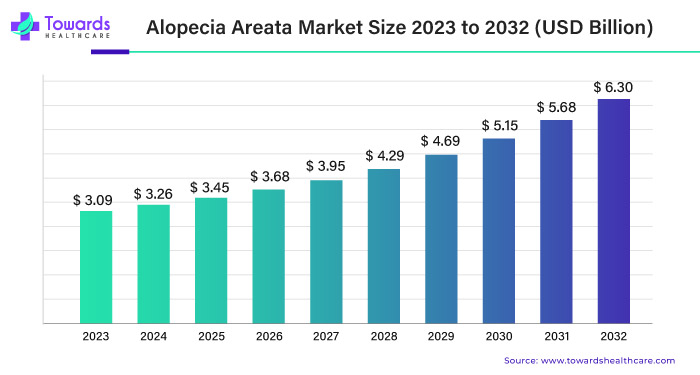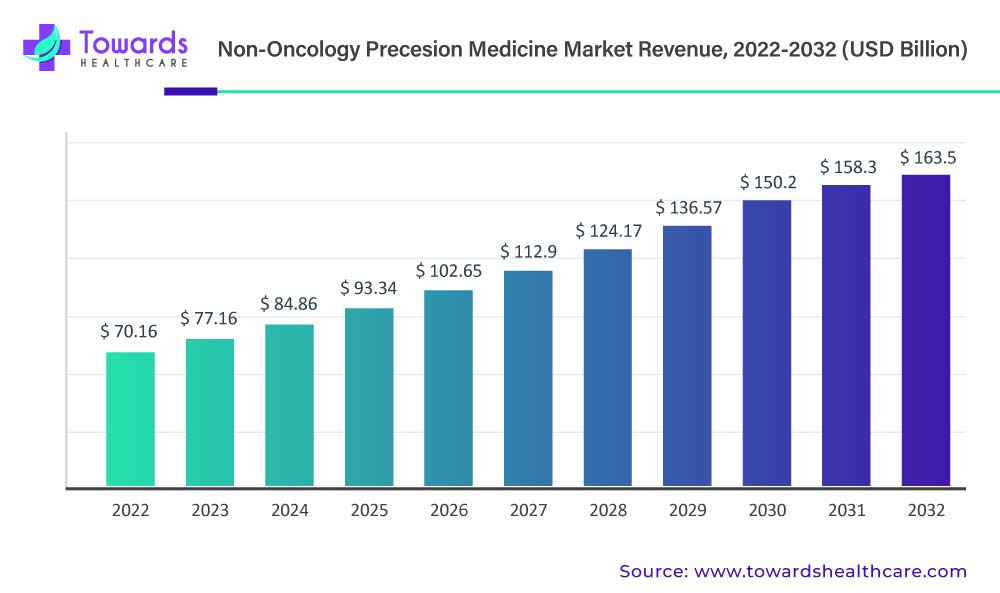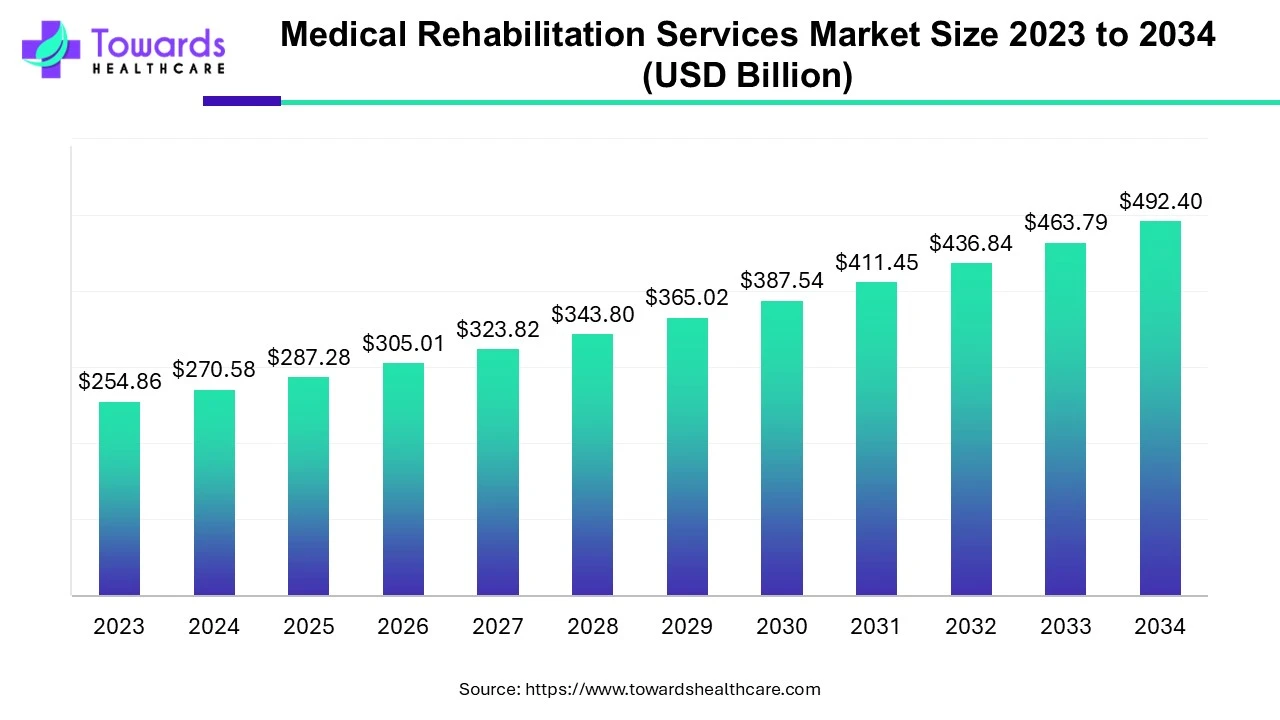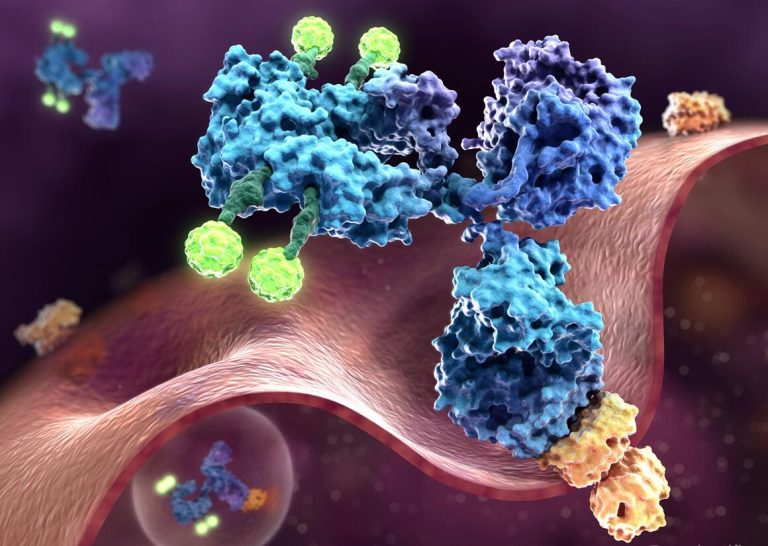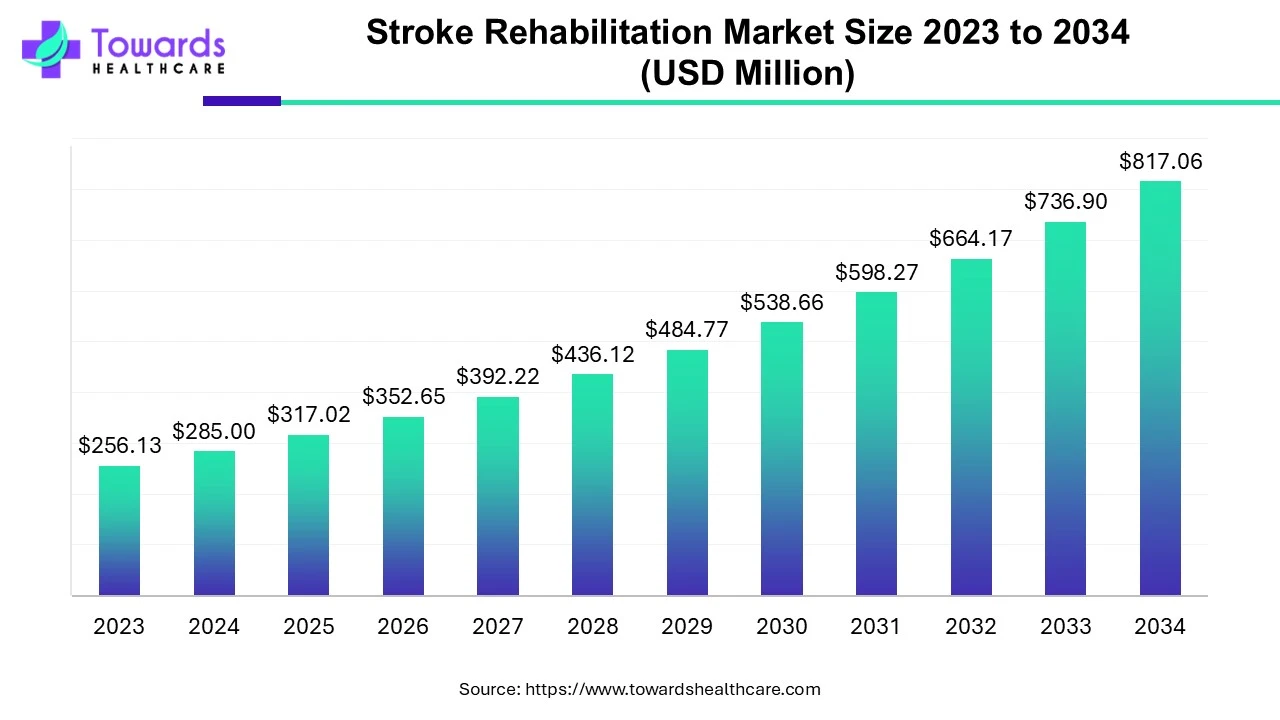The report covers Protein Labeling Market Trends and Segments Analysis by product, method, application and region. By product includes reagents (proteins, enzymes, probes/tags, monoclonal antibodies and other reagents), kits and services. Methods are divided into in-vitro labeling methods (such as enzymatic labeling, dye-based labeling, co-translational labeling, site-specific labeling, nanoparticle labeling and others) and in-vivo labeling methods (including photoreactive and radioactive labeling, among others). Applications encompass immunological techniques, cell-based arrays, fluorescence microscopy, protein microarray and mass spectrometry. The report offers the value (in USD Billion) for the above segments.
Global Protein Labeling Market Growth Forecast
The global protein labeling market size valued at approximately USD 2.46 billion in 2023, is anticipated to expand to USD 5.55 billion by 2033. This growth represents a compound annual growth rate (CAGR) of 8.48% from 2024 to 2033. The rising demand for protein labeling is driven by its applications in research and disease diagnosis.
Protein labeling encompasses methods for modifying proteins, such as adding fluorophores, biotin, and other small molecules to study protein interactions and folding. These techniques are crucial in various fields, including genetics, forensics, biology, biotechnology, and medicine. Chemical tagging using low-molecular-weight probes is a fundamental approach in chemical biology, enabling researchers to explore diverse protein features and biological activities. The market’s primary objectives include measuring biological processes, quantifying compounds, identifying specific protein modifications and isoforms in complex samples, enhancing detection sensitivity, and optimizing detection workflows.
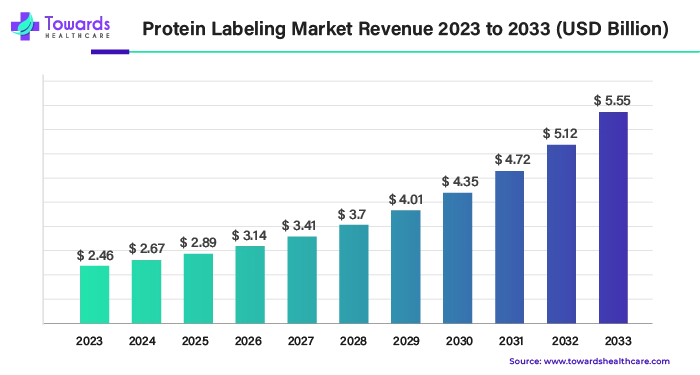
Protein Labeling Market TOC | Table of Content
Introduction
- Definition and Scope of the Market
- Objectives of the Study
- Market Segmentation
- Research Methodology
- Data Sources
Executive Summary
- Market Overview
- Key Findings
- Market Trends
- Competitive Landscape
- Market Dynamics
Market Dynamics
- Drivers
- Increasing Research and Development Activities
- Growing Demand for Protein Labeling in Proteomics Research
- Technological Advancements in Labeling Techniques
- Restraints
- High Cost of Reagents and Kits
- Regulatory Challenges
- Opportunities
- Emerging Markets
- Advancements in Label-Free Techniques
- Challenges
- Complexities in Protein Labeling
Market Analysis
- Market Size and Forecast
- Market Share Analysis
- Growth Rate Analysis
- Market Trends
Market Segments
- By Product
- Reagents
- Proteins
- Enzymes
- Probes/Tags
- Monoclonal Antibodies
- Other Reagents
- Kits
- Services
- Reagents
- By Method
- In-vitro Labeling Methods
- Enzymatic Labeling
- Dye-based Labeling
- Co-translational Labeling
- Site-specific Labeling
- Nanoparticle Labeling
- Others
- In-vivo Labeling Methods
- Photoreactive Labeling
- Radioactive Labeling
- Others
- In-vitro Labeling Methods
- By Application
- Immunological Techniques
- Cell-based Arrays
- Fluorescence Microscopy
- Protein Microarray
- Mass Spectrometry
- By Region
- North America
- Europe
- Asia Pacific
- Latin America
- MEA
Cross Segmental Analysis
By Product
- Reagents
- Proteins
- Market Value and Volume in Different Labeling Methods
- Application in Immunological Techniques vs. Mass Spectrometry
- Enzymes
- Market Value and Volume by Application (e.g., Cell-based Arrays vs. Fluorescence Microscopy)
- Probes/Tags
- Market Value and Volume by Method (e.g., Dye-based vs. Nanoparticle Labeling)
- Monoclonal Antibodies
- Market Value and Volume by Application (e.g., Protein Microarray vs. Mass Spectrometry)
- Other Reagents
- Market Value and Volume in Various Methods and Applications
- Proteins
- Kits
- Market Value and Volume by Method
- In-vitro vs. In-vivo Labeling Methods
- Market Value and Volume by Application
- Immunological Techniques vs. Protein Microarray
- Market Value and Volume by Method
- Services
- Market Value and Volume by Application
- Custom Labeling Services for Cell-based Arrays vs. Mass Spectrometry
- Market Value and Volume by Region
- North America vs. Asia-Pacific
- Market Value and Volume by Application
By Method
- In-vitro Labeling Methods
- Enzymatic Labeling
- Market Value and Volume by Product (e.g., Enzymes vs. Probes/Tags)
- Dye-based Labeling
- Market Value and Volume by Application (e.g., Fluorescence Microscopy vs. Protein Microarray)
- Co-translational Labeling
- Market Value and Volume by Product and Region
- Site-specific Labeling
- Market Value and Volume by Application and Region
- Nanoparticle Labeling
- Market Value and Volume by Application and Product
- Others
- Market Value and Volume across Various Applications
- Enzymatic Labeling
- In-vivo Labeling Methods
- Photoreactive Labeling
- Market Value and Volume by Application (e.g., Immunological Techniques vs. Cell-based Arrays)
- Radioactive Labeling
- Market Value and Volume by Product and Region
- Others
- Market Value and Volume by Method and Application
- Photoreactive Labeling
By Application
- Immunological Techniques
- Market Value and Volume by Product
- Reagents vs. Kits
- Market Value and Volume by Method
- In-vitro vs. In-vivo Labeling
- Market Value and Volume by Product
- Cell-based Arrays
- Market Value and Volume by Product
- Proteins vs. Enzymes
- Market Value and Volume by Method
- Enzymatic vs. Dye-based Labeling
- Market Value and Volume by Product
- Fluorescence Microscopy
- Market Value and Volume by Product
- Probes/Tags vs. Kits
- Market Value and Volume by Method
- Dye-based vs. Nanoparticle Labeling
- Market Value and Volume by Product
- Protein Microarray
- Market Value and Volume by Product
- Monoclonal Antibodies vs. Other Reagents
- Market Value and Volume by Method
- Co-translational vs. Site-specific Labeling
- Market Value and Volume by Product
- Mass Spectrometry
- Market Value and Volume by Product
- Enzymes vs. Probes/Tags
- Market Value and Volume by Method
- Nanoparticle vs. Enzymatic Labeling
- Market Value and Volume by Product
By Region
- North America
- Market Value and Volume by Product
- Reagents vs. Kits
- Market Value and Volume by Method
- In-vitro vs. In-vivo Labeling
- Market Value and Volume by Application
- Immunological Techniques vs. Cell-based Arrays
- Market Value and Volume by Product
- Europe
- Market Value and Volume by Product
- Proteins vs. Monoclonal Antibodies
- Market Value and Volume by Method
- Dye-based vs. Photoreactive Labeling
- Market Value and Volume by Application
- Fluorescence Microscopy vs. Mass Spectrometry
- Market Value and Volume by Product
- Asia-Pacific
- Market Value and Volume by Product
- Enzymes vs. Kits
- Market Value and Volume by Method
- Site-specific vs. Radioactive Labeling
- Market Value and Volume by Application
- Protein Microarray vs. Immunological Techniques
- Market Value and Volume by Product
- Latin America
- Market Value and Volume by Product
- Probes/Tags vs. Other Reagents
- Market Value and Volume by Method
- Nanoparticle vs. Enzymatic Labeling
- Market Value and Volume by Application
- Cell-based Arrays vs. Mass Spectrometry
- Market Value and Volume by Product
- Middle East and Africa
- Market Value and Volume by Product
- Monoclonal Antibodies vs. Services
- Market Value and Volume by Method
- Photoreactive vs. Co-translational Labeling
- Market Value and Volume by Application
- Immunological Techniques vs. Fluorescence Microscopy
- Market Value and Volume by Product
Go-to-Market Strategies (Selective Region)
- Market Segmentation and Targeting
- Identify key market segments
- Develop targeted marketing strategies
- Focus on high-growth regions and applications
- Product Differentiation and Positioning
- Highlight unique features and benefits
- Position products by application
- Develop a strong value proposition
- Pricing Strategy
- Competitive pricing analysis
- Value-based pricing for premium products
- Discount strategies for bulk purchases
- Distribution Channels
- Establish partnerships with key distributors
- Leverage online sales platforms
- Develop direct sales channels
- Sales and Marketing
- Invest in a skilled sales force
- Utilize digital marketing strategies
- Participate in industry conferences and trade shows
- Customer Relationship Management
- Develop relationships with key opinion leaders
- Provide excellent customer support
- Implement loyalty programs
- Regulatory and Compliance
- Ensure compliance with regulatory standards
- Obtain necessary certifications
- Monitor regulatory changes
- Research and Development
- Invest in continuous R&D
- Collaborate with research institutions
- Focus on developing new labeling techniques
- Strategic Partnerships and Alliances
- Form strategic alliances for co-development
- Partner with academic institutions
- Establish relationships with CROs
- Market Entry and Expansion
- Develop a phased market entry strategy
- Focus on entering high-growth markets
- Plan for gradual expansion
- Risk Management
- Identify potential risks
- Monitor market trends and competitor activities
- Adapt strategies based on market feedback
- Performance Metrics and Monitoring
- Set clear performance metrics
- Regularly monitor sales performance and customer feedback
- Adjust strategies based on performance data
Integration of AI in Protein Labeling Market
- Enhanced Data Analysis
- Use AI algorithms to analyze large datasets for identifying patterns and insights.
- Improve accuracy and efficiency in protein identification and quantification.
- Automation of Labeling Processes
- Implement AI-driven automation for labeling processes to increase throughput.
- Reduce human error and enhance reproducibility in experimental procedures.
- Predictive Modeling
- Develop AI models to predict labeling outcomes based on protein structure and function.
- Optimize labeling protocols by simulating different conditions and parameters.
- Advanced Imaging and Detection
- Utilize AI for image analysis in fluorescence microscopy and other imaging techniques.
- Enhance detection sensitivity and specificity through AI-powered image processing.
- Custom Labeling Solutions
- Offer AI-based custom labeling solutions tailored to specific research needs.
- Use machine learning to design novel probes and tags for specialized applications.
- Market and Trend Analysis
- Employ AI to analyze market trends and predict future demands.
- Identify emerging opportunities and potential market shifts.
- Personalized Customer Support
- Implement AI-driven chatbots and virtual assistants for customer support.
- Provide personalized recommendations and troubleshooting based on customer queries.
- Research and Development Acceleration
- Leverage AI to accelerate R&D efforts in developing new labeling techniques.
- Use AI to streamline experimental design and hypothesis testing.
- Integration with Existing Technologies
- Combine AI with existing technologies like mass spectrometry and immunological techniques.
- Enhance the overall workflow and performance of protein labeling applications.
Key Strategic Areas in Protein Labeling Market
- Opportunity Assessment
- Identifying Market Gaps
- Analyzing Emerging Trends
- Competitive Landscape Evaluation
- New Product Development
- Innovation in Labeling Techniques
- Prototyping and Testing
- Product Launch Strategy
- Plan Finances/ROI Analysis
- Cost-Benefit Analysis
- Investment Strategies
- ROI Forecasting and Management
- Supply Chain Intelligence/Streamline Operations
- Supply Chain Optimization
- Vendor and Partner Management
- Logistics and Distribution Efficiency
- Cross Border Intelligence
- International Market Analysis
- Regulatory and Compliance Insights
- Global Expansion Strategies
- Business Model Innovation
- Developing Flexible Business Models
- Exploring New Revenue Streams
- Adapting to Market Changes
- Blue Ocean vs. Red Ocean Strategies
- Identifying Untapped Markets (Blue Ocean)
- Competitive Strategies in Saturated Markets (Red Ocean)
- Strategic Positioning and Differentiation
Competitive Landscape
- Overview
- Market Share Analysis
- Key Developments and Strategies
- Company Profiles
- Thermo Fisher Scientific, Inc.
- Market Value and Volume
- Key Products and Services
- Recent Developments
- LI-COR, Inc.
- Shiru
- F. Hoffmann-La Roche Ltd
- Jena Bioscience GmbH
- Merck KGaA
- New England Biolabs
- Promega Corporation
- Revvity Inc.
- LGC Ltd
- Agilent Technologies Inc.
- Danaher (Cytiva)
- EvolutionaryScale
- Other Key Players
- Thermo Fisher Scientific, Inc.
Future Outlook
- Market Forecast
- Emerging Trends
- Strategic Recommendations
Appendix
- List of Abbreviations
- Methodology
- Primary Research
- Secondary Research
- Assumptions
- Disclaimer
To own our research study instantly, Click here @ https://www.towardshealthcare.com/price/5171
You can place an order or ask any questions, please feel free to contact us at sales@towardshealthcare.com
About Us
Towards Healthcare is a leading global provider of technological solutions, clinical research services, and advanced analytics to the healthcare sector, committed to forming creative connections that result in actionable insights and creative innovations. We are a global strategy consulting firm that assists business leaders in gaining a competitive edge and accelerating growth. We are a provider of technological solutions, clinical research services, and advanced analytics to the healthcare sector, committed to forming creative connections that result in actionable insights and creative innovations.
Explore the comprehensive statistics and insights on healthcare industry data and its associated segmentation: Get a Subscription
For Latest Update Follow Us: https://www.linkedin.com/company/towards-healthcare
